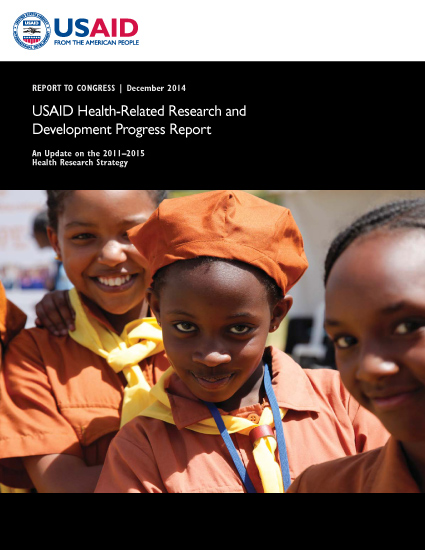Speeches Shim
At the founding of the U.S. Agency for International Development (USAID), Presi-dent John F. Kennedy said, “Our problems are man-made, thus they can be solved by man.” For more than 50 years, USAID has leveraged science, technology, and research to develop, introduce, and deliver low cost, high-impact interventions improving health and saving lives. This longstanding commit-ment has resulted in the development of technologies, tools, and interventions like oral rehydration salts to prevent diarrheal deaths in children and the Demographic and Health Surveys – the standard for demographic and health information for measurement and decision-making.
President Barack Obama has committed his administration to ending extreme poverty in two decades. In support of this objective, USAID is undertaking the Global Health Initiative (GHI) to accelerate the rate of progress in reducing preventable mortality and improving health. GHI is implemented through three focus efforts that target the main causes of mortality and burden of disease in developing countries: Ending Pre-ventable Child and Maternal Deaths, Creat-ing an AIDS-Free Generation, and Protect-ing Communities from Infectious Diseases. Each one has ambitious but achievable targets and includes a strong focus on measurement and the development and application of research and innovation. In support of these goals, USAID has renewed its commitment to innovation and health systems strengthening through efforts such as the Grand Challenges initiatives, which include the Saving Lives at Birth and Fighting Ebola programs, as well as through the establishment of the Offi ce of Health Systems. In partnerships with developing coun-tries, USAID is well positioned to scale up evidence-based interventions.
To accelerate the development and introduction of re-search, USAID works along a research-to-use continuum. Its approach involves needs assessments to inform research, product development, and other activities that are needed to guide and accelerate the intro-duction and scale-up of evidence-based interventions.
Under this research-to-use strategic framework, we are better able to identify and accelerate the availability of the most promising opportunities that would benefi t partner country health systems. USAID also engages with multiple support-ing partners, including the U.S. Centers for Disease Control and Prevention, the Na-tional Institutes of Health, the Department of Defense, multilateral and donor agencies, foundations, universities, non-governmental organizations, and commercial-sector part-ners, to address country-specifi c and global challenges, and establish the evidence base for the development of consensus on tech-nical and policy issues. Concurrent to its research and research introduction efforts, USAID strengthens research and technical capabilities in partner countries. This current report is a progress update on the health research goals, established as part of the Bureau for Global Health’s 5-year (2011–2015) Health Research Strategy. USAID uses a managed research process to meet these goals. Most objectives are in the fi nal stages or have already been completed. Highlights of this year’s report include the following accomplishments: Ending Preventable Child and Maternal Deaths• Advanced, in partnership with the Helping Babies Breathe program, the introduction and coverage of life-saving newborn resus-citation training and devices in health facili-ties in seven countries. USAID is developing a low-cost and easy-to-use upright neona-tal resuscitator. This model has the potential to save more lives because it delivers more volume, prevents air leakage, and has easier assembly and disassembly. • Supported three promising new insec-ticide candidates to fi ght malaria that are anticipated to reach the fi nal stages of development in 2019. These new insecticides will be particularly important for addressing resistance in areas that are highly endemic to malaria.• Chlorhexidine, a low-cost antiseptic, has been demonstrated to reduce neonatal mortality from umbilical cord infection. USAID funded early clinical trials, ac-celerated its development, supported the scale-up in Nepal through Saving Lives at Birth, and is now accelerating its intro-duction in 12 more countries.
• Testing strategies to successfully intro-duce new products to increase options for women-initiated contraception. These innovative methods were designed to address women’s concerns about side effects, options for infrequent sex, and safety during breast feeding. • Anticipated challenges to adoption of effective cookstove technologies to help reduce indoor air pollution. These US-AID-funded studies have contributed to the understanding of cooking behaviors and the most effective ways to maximize low emission cookstove use.AIDS-Free Generation• Continued to support promising, large-scale, effi cacy trials in HIV prevention. Ongoing studies include examining teno-fovir vaginal gel and the monthly dapivirine vaginal ring. USAID is undertaking planning for licensure, introduction, and scale of new HIV prevention products for women. Protecting Communities from Infectious Diseases/Global Health Security Agenda• Advanced development of diagnostic tools and regimens to address tuberculo-sis (TB). USAID supported tool diag-nostic development to more effectively detect TB in individuals with and without HIV and supported research to examine regimens that improve the treatment of multidrug-resistant TB (MDR-TB).• Identifi ed novel viruses to more effec-tively target surveillance, raise awareness of risks, and engage partner governments on issues of early response. USAID supported a new set of viral pathogen detection protocols and a global network of laboratories to obtain information on 315 novel viruses.America’s investments in global health research and development not only improve and save lives, but also help build stronger families, communities, and nations; foster stability; and contribute to economic growth. Though global health research and development represents a small portion of the federal budget, it makes important con-tributions toward advancing our national security, promoting our economic interests, and reaffi rming our country’s exceptional role in the world.


Comment
Make a general inquiry or suggest an improvement.